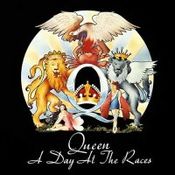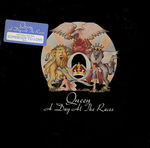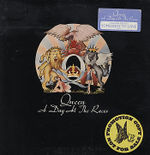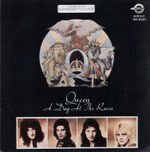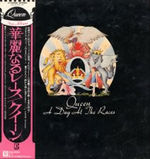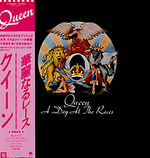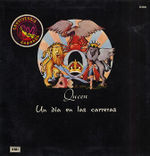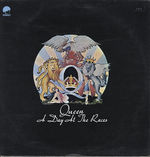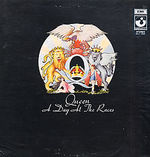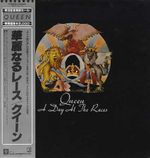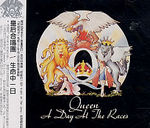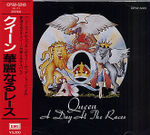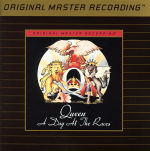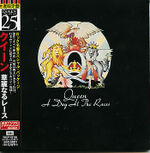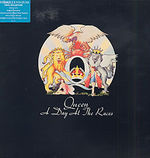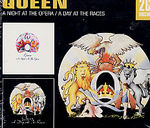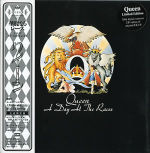From Queenpedia.com
(→Tracklists) |
|||
| Line 1: | Line 1: | ||
__notoc__ | __notoc__ | ||
| - | |||
[[Image:Queen_races.jpg|thumb|175px|right|A Day At The Races, 1976]] | [[Image:Queen_races.jpg|thumb|175px|right|A Day At The Races, 1976]] | ||
| + | After the release of Queen's fourth album, [[A Night At The Opera]], and the resulting tour that ran from November 1975 until April 1976, the band had a new management ([[John Reid]]) and decided to take some time to enjoy everything that being world famous rock stars had to offer; for Brian, this meant marrying his long-standing girlfriend, [[Chrissy Mullen]], on May 29th, over a month after the band's last live date. Clearly, they weren't in any rush to be back on the road or in the studio; in July, they finally began work on the follow-up to [[A Night At The Opera]], recording material at three studios (compared to its predecessor's seven): [[The Manor]], [[Wessex Studios]], and [[Sarm Studios]]. | ||
| + | Unlike the sessions for [[A Night At The Opera]], the band weren't under any pressing schedules to quickly record an album and go out on the road to promote it; in fact, apart from four concerts in September, the band wouldn't tour again until January 1977. Three of those four concerts (two at the Playhouse Theatre in Edinburgh on September 1st and 2nd, and one at Cardiff Castle on September 10th) were as part of festivals, while the fourth date, on September 18th (coincidentally, the sixth anniversary of [[Jimi Hendrix]]'s untimely death), was held at Hyde Park, organized by the band to be a free event to thank their British fans for being so loyal to them, even as Queen's popularity grew exponentially. | ||
| + | |||
| + | Because these live dates came midway through the recording sessions, it only made sense that some of the new songs be incorporated into the set: [[Tie Your Mother Down]] and [[You Take My Breath Away]] were both played, becoming one of the rare times when new material would be performed live before being officially released; also new to the set was an acoustic interlude, with the latter new song as well as Brian's [['39]], performed by the band at the front of the stage with Freddie on lead vocals and Roger banging away on a bass drum and tambourine. Apart from a minor snafu that threatened to become a major headache (the band's set overran by half an hour, and because of strict time restrictions, the police were called to make sure the band didn't go back out; the band reluctantly agreed not to, particularly Freddie, who wouldn't have been much pleased being hauled away to jail wearing his white spandex suit!), the night was a success, and the band would speak highly of the gig for years after. | ||
| + | |||
| + | Following the concerts, it was back to work on the new album. For the first time, Queen were unassisted by a producer, evidently feeling that they had done all they could do with [[Roy Thomas Baker]], preferring to work on their own (as ever, Mike Stone helped engineer the album). The sessions finally concluded in November, and the following month, ''A Day At The Races'' was released to much acclaim, though some critics were quick to point out that the band were merely rehashing a formula which had worked so well on the previous album, sighing that the formula had become stale and didn't work on the new album. Unlike [[A Night At The Opera]], the material isn't as diverse here, though it's easy to see the parallels between the two similarly-themed albums: [[You Take My Breath Away]] is an update of [[Love Of My Life]], while [[The Millionaire Waltz]] takes the studio trickery and adventurousness of [[Bohemian Rhapsody]], though critics claimed that [[Somebody To Love]] was the new [[Bohemian Rhapsody]]. John Deacon gets another lovely pop song in the form of [[You And I]], which could be seen as a superior rewrite of [[You're My Best Friend]], while [[Good Old-Fashioned Lover Boy]] was written in the same vein as Freddie's previous vaudeville / music hall-inspired material like [[Seaside Rendezvous]], [[Lazing On A Sunday Afternoon]], and [[Bring Back That Leroy Brown]]. However, that's where the similarities end; the material on ''A Day At The Races'' is heavier and more deliberate, preferring performance and atmosphere over perfection. | ||
| + | |||
| + | The first single from the album, [[Somebody To Love]], reached #2 in the UK and a respectable #13 in the US, while subsequent singles didn't perform as well: [[Tie Your Mother Down]] peaked at #31 in the UK and #49 in the US, and [[Queen's First EP]], with [[Good Old-Fashioned Lover Boy]] being the main track, reached #17 in the UK (the EP wasn't released at all in the US; instead, [[Long Away]] was released, but failed to chart due to an absence of a performance video and Freddie's instantly recognizable lead vocals). Like its predecessor, the album sailed into the UK charts at #1 and reached #5 in the US. In 1991, the album was re-released on CD in the US with two remixes of [[Tie Your Mother Down]] and [[Somebody To Love]], featuring only minor, subtle differences to the originals. | ||
| + | |||
| + | == Tracklists == | ||
{| | {| | ||
|valign="top" style="width:250px;"| | |valign="top" style="width:250px;"| | ||
| Line 33: | Line 42: | ||
# [[Somebody To Love | Somebody To Love (remix)]] | # [[Somebody To Love | Somebody To Love (remix)]] | ||
|} | |} | ||
| - | |||
| - | |||
| - | |||
| - | |||
| - | |||
| - | |||
| - | |||
| - | |||
| - | |||
| - | |||
| - | |||
==Credits== | ==Credits== | ||
Revision as of 01:40, 14 June 2007
After the release of Queen's fourth album, A Night At The Opera, and the resulting tour that ran from November 1975 until April 1976, the band had a new management (John Reid) and decided to take some time to enjoy everything that being world famous rock stars had to offer; for Brian, this meant marrying his long-standing girlfriend, Chrissy Mullen, on May 29th, over a month after the band's last live date. Clearly, they weren't in any rush to be back on the road or in the studio; in July, they finally began work on the follow-up to A Night At The Opera, recording material at three studios (compared to its predecessor's seven): The Manor, Wessex Studios, and Sarm Studios.
Unlike the sessions for A Night At The Opera, the band weren't under any pressing schedules to quickly record an album and go out on the road to promote it; in fact, apart from four concerts in September, the band wouldn't tour again until January 1977. Three of those four concerts (two at the Playhouse Theatre in Edinburgh on September 1st and 2nd, and one at Cardiff Castle on September 10th) were as part of festivals, while the fourth date, on September 18th (coincidentally, the sixth anniversary of Jimi Hendrix's untimely death), was held at Hyde Park, organized by the band to be a free event to thank their British fans for being so loyal to them, even as Queen's popularity grew exponentially.
Because these live dates came midway through the recording sessions, it only made sense that some of the new songs be incorporated into the set: Tie Your Mother Down and You Take My Breath Away were both played, becoming one of the rare times when new material would be performed live before being officially released; also new to the set was an acoustic interlude, with the latter new song as well as Brian's '39, performed by the band at the front of the stage with Freddie on lead vocals and Roger banging away on a bass drum and tambourine. Apart from a minor snafu that threatened to become a major headache (the band's set overran by half an hour, and because of strict time restrictions, the police were called to make sure the band didn't go back out; the band reluctantly agreed not to, particularly Freddie, who wouldn't have been much pleased being hauled away to jail wearing his white spandex suit!), the night was a success, and the band would speak highly of the gig for years after.
Following the concerts, it was back to work on the new album. For the first time, Queen were unassisted by a producer, evidently feeling that they had done all they could do with Roy Thomas Baker, preferring to work on their own (as ever, Mike Stone helped engineer the album). The sessions finally concluded in November, and the following month, A Day At The Races was released to much acclaim, though some critics were quick to point out that the band were merely rehashing a formula which had worked so well on the previous album, sighing that the formula had become stale and didn't work on the new album. Unlike A Night At The Opera, the material isn't as diverse here, though it's easy to see the parallels between the two similarly-themed albums: You Take My Breath Away is an update of Love Of My Life, while The Millionaire Waltz takes the studio trickery and adventurousness of Bohemian Rhapsody, though critics claimed that Somebody To Love was the new Bohemian Rhapsody. John Deacon gets another lovely pop song in the form of You And I, which could be seen as a superior rewrite of You're My Best Friend, while Good Old-Fashioned Lover Boy was written in the same vein as Freddie's previous vaudeville / music hall-inspired material like Seaside Rendezvous, Lazing On A Sunday Afternoon, and Bring Back That Leroy Brown. However, that's where the similarities end; the material on A Day At The Races is heavier and more deliberate, preferring performance and atmosphere over perfection.
The first single from the album, Somebody To Love, reached #2 in the UK and a respectable #13 in the US, while subsequent singles didn't perform as well: Tie Your Mother Down peaked at #31 in the UK and #49 in the US, and Queen's First EP, with Good Old-Fashioned Lover Boy being the main track, reached #17 in the UK (the EP wasn't released at all in the US; instead, Long Away was released, but failed to chart due to an absence of a performance video and Freddie's instantly recognizable lead vocals). Like its predecessor, the album sailed into the UK charts at #1 and reached #5 in the US. In 1991, the album was re-released on CD in the US with two remixes of Tie Your Mother Down and Somebody To Love, featuring only minor, subtle differences to the originals.
Tracklists
|
Vinyl version
|
1991 Hollywood Records CD |
Credits
- Musicians:
- Freddie Mercury - vocals, piano, choir meister, tantrums, choir vocals on Somebody To Love
- Brian May - guitars, vocals, leader of the orchestra, introduction on Tie Your Mother Down, lead vocals on Long Away, guitar orchestrations on The Millionaire Waltz, choir vocals on Somebody To Love, slide guitar on Drowse, harmonium, piano and plastic piano on Teo Torriatte (Let Us Cling Together)
- Roger Taylor - drums, vocals, percussion, pandemonium, choir vocals on Somebody To Love, rhythm guitar and lead vocals on Drowse
- John Deacon - Fender bass, acoustic guitar on You And I
- Mike Stone - additional vocals on Good Old-Fashioned Lover Boy
- Produced by: Queen.
- Recorded: July - November 1976 at The Manor, Oxfordshire; Wessex Studios, Highbury; Sarm Studios, Aldgate.
Charts
| Country | Release date | First appearance in charts | Peak position | Chart run | Weeks in chart | Additional comments |
| UK | - | 25 December 1976 | 1 | 8-8-1-3-3-6-11-15-22-30-31-27-32-34-27-39-44-39-41-43 | 20 weeks, 6 in Top Ten, 1 at #1 | First run in UK charts |
| UK | - | 9 July 1977 | 56 | 56-0-57-0-56-58 | 4 weeks, 24 weeks total | Second and final run in UK charts |
| USA | - | 15 January 1977 | 5 | 36-21-8-6-5-9-23-27-53-62-59-58-81-113-113-119-119-150-170 | 19 weeks, 4 weeks in Top Ten | First run in US |
Information supplied by Fedepeti, 24 August 2004
- Japan: #1, in chart for 11 weeks.
- Holland: #1.
- Italy: #15, in chart for 11 weeks.
Liner notes
- Notes
Additional info
- Info
Reviews
Winnipeg Free Press, 1977
It's important in rock to know when to move to new musical ground and when to stick with what you've got. By staying close to the perimeters of last year's hugely successful A Night at the Opera, Queen has another massive bestseller in A Day at the Races. David Bowie could benefit from Queen's counsel. Low, Bowie's latest change of direction, adds to the Englishman's colorful, elusive persona, but the album's icy disorienting Kraftwerk Meets Eno experimentals rock leaves me wanting less persona and more music. Bowie's popularity will push Low.into the Top 10 alongside A Day at the Races, but its stay there should be brief.
Queen's A Day at the Races (Elektra 6E 101) — from the start, Queen has aimed high. "You have to have a lot of confidence in this business." said the group's lead singer Freddie Mercury after the band's first hit in 1973.
"It's useless saying to yourself, 'Maybe I'm not good enough, maybe I'd better settle for second place'. "The whole group aimed for the top spot. We're not going to be content with anything else."
Last year's A Night at the Opera album — the group's fourth — finally gave Queen its shot at superstardom. Opera spent 47 weeks on the national sales charts, spawned two hit singles and showed the band capable of both the high energy of Led Zeppelin and its own wonderfully eccentric pieces such as Bohemian Rhapsody. Realizing the impact of the album, the stylish English quartet has reprogrammed much of the variety and charm of Opera in its new collection. The cover art work is similar, the title again is from a Marx Brothers film and the music even begins with the gong sound that closed Bohemian Rhapsody.
There are similarities, too, in the songs. The Millionaire Waltz recalls the ambition and pose of Bohemian Rhapsody; White Man has much of the guitar bravado of The Prophet's Song: You and I suggests the diarming romantic charm of You're My Best Friend.
While this reliance on familiar strains puts Races in the shadow of Opera, the band has approached the individual tracks with a care and skill that gives them their own personality and punch. More than-simply a repeat, of its last work. Races is a reconfirmation of Queen's position as the best of the third wave of English rock groups.
Additional Reviews
Sleeves
|
| |||
|
| |||
|
| |||
|
| |||
